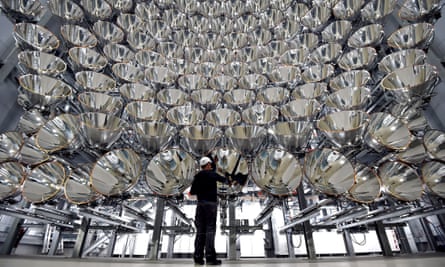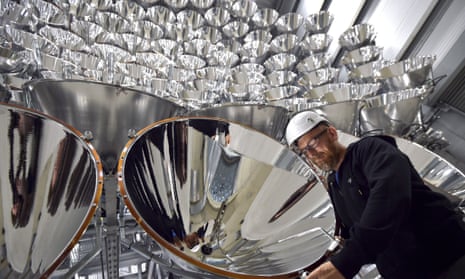German scientists are switching on “the world’s largest artificial sun” in the hope that intense light sources can be used to generate climate-friendly fuel.
The Synlight experiment in Jülich, about 19 miles west of Cologne, consists 149 souped-up film projector spotlights and produces light about 10,000 times the intensity of natural sunlight on Earth.
When all the lamps are swivelled to concentrate light on a single spot, the instrument can generate temperatures of around 3,500C – around two to three times the temperature of a blast furnace.

“If you went in the room when it was switched on, you’d burn directly,” said Prof Bernard Hoffschmidt, a research director at the German Aerospace Center, where the experiment is housed in a protective radiation chamber.
The aim of the experiment is to come up with the optimal setup for concentrating natural sunlight to power a reaction to produce hydrogen fuel.
Solar power stations that use mirrors to focus sunlight onto water are already well established. These work by harnessing heat from the sun to produce steam that turns turbines and generates electricity.

The Synlight experiment is investigating the possibility that a similar setup could be used to power a reaction to extract hydrogen from water vapour, which could then be used as a fuel source for aeroplanes and cars.
Synlight currently uses a vast amount of energy – four hours of operation consumes as much electricity as a four-person household in a year – but scientists hope that in the future natural sunlight could be used to produce hydrogen in a carbon-neutral way.
“We’d need billions of tonnes of hydrogen if we wanted to drive aeroplanes and cars on CO2-free fuel,” said Hoffschmidt. “Climate change is speeding up so we need to speed up innovation.”

Comments (…)
Sign in or create your Guardian account to join the discussion